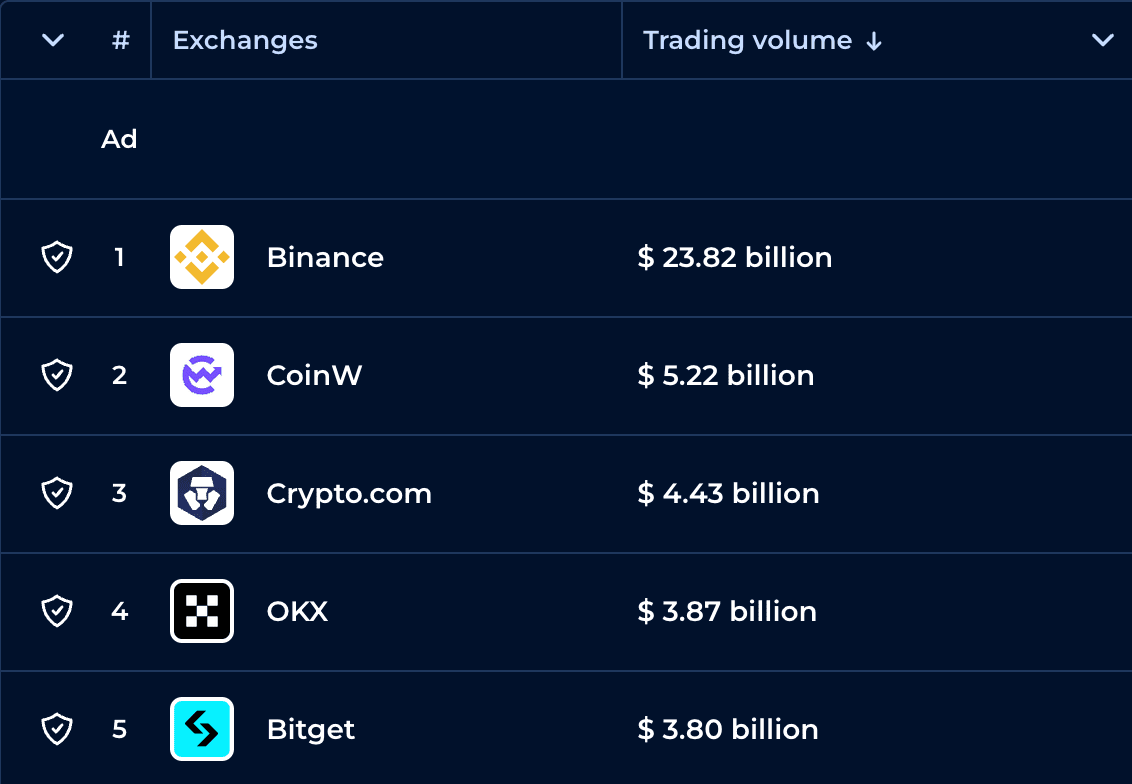Binance reinforces its dominant position with trading volumes far exceeding the entire market in 2025.
Binance's trading volume in 2025 has surpassed the total of all major competitors combined, ushering in a new phase for the concentration of activity in the cryptocurrency trading market.
According to data from CryptoQuant, Binance processes trading volumes double that of all other exchanges combined, raising questions about global liquidity structure. Data from TokenInsight shows that in Q1 2025, Binance recorded approximately $8.39 trillion in trades, accounting for 36.5% of the total market despite a decline in overall volume.
During this period, Binance's average daily trading volume reached $36.6 billion, far exceeding Bybit ($7.9 billion), OKX ($6.5 billion), and Coinbase ($5.6 billion). The spot trading volume alone surpassed $1.9 trillion, more than the total of Coinbase, Crypto.com, and OKX.
By mid-year, the level of market share concentration became even clearer as Binance's spot volume was nearly 8 times that of Coinbase, helping the exchange capture about 42% of the global market share. Notably, in June, Binance's spot trading volume nearly approached the total of all other exchanges combined – a rare occurrence since early 2024 when Bitcoin surpassed the $70,000 mark.
Binance's strength does not stop at spot trading but also extends to futures contracts, stablecoin capital flows, investment flows, and on-chain metrics. In the summer of 2025, when Bitcoin reached a new historical peak, Binance recorded trading volumes nearly double that of the entire market combined, even as overall liquidity declined.
However, this high level of concentration raises concerns. The European Securities and Markets Authority (ESMA) has warned that a platform holding too large a share is a 'significant concern' regarding systemic risk. The current market structure also shows uneven liquidity distribution: Binance leads in spot trading, but OKX excels in liquidation volume, reflecting different risk dynamics.
History shows that Binance's dominance often coincides with price volatility. The volume imbalance earlier in 2024 preceded a strong surge in Bitcoin. The question is whether the current concentration can continue to affect the price trends of major assets.
Another important factor is the legal angle. The settlement agreement with the U.S. Department of Justice at the end of 2023 was seen by some observers as an acknowledgment that Binance is 'too big to fail' without causing market disruptions. This perspective continued to be reinforced in 2025 as the exchange maintained its top position despite a contracting market.

The detailed numbers further highlight the gap: on average, Binance achieves $36.6 billion daily, nearly 9 times that of Coinbase, while the 42% market share in the spot segment marks the highest level in 10 months.
Despite the entire industry experiencing a decline in volume, Binance still maintains its overwhelming position, equal to or surpassing the total of its competitors, reshaping the balance of the global trading market in 2025.
What is too big to fail?
A classic example of 'too big to fail' is the 2008 financial crisis in the U.S. At that time, many major banks and financial institutions like Lehman Brothers, AIG, Citigroup faced liquidity crises.
The U.S. government and the Federal Reserve (FED) are concerned that if these institutions were to experience mass bankruptcies, the global financial system would collapse in a chain reaction, causing a severe recession. Therefore, the government has implemented emergency bailout packages, injecting hundreds of billions of dollars to maintain the operations of major banks, except for Lehman Brothers which was forced to file for bankruptcy – a move that shocked the world.
This illustrates the concept: when an organization holds a position too critical in the system, its collapse can bring systemic risks, forcing regulators to intervene to avoid a larger crisis.